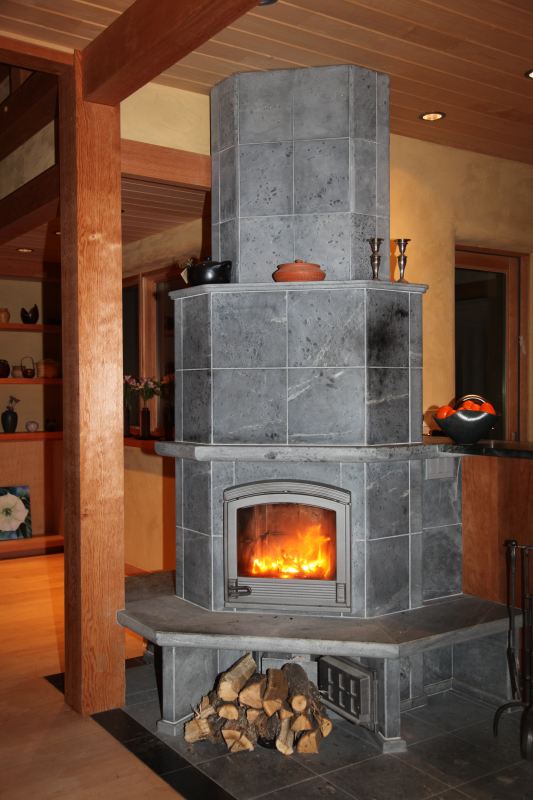Although forced air is the most common form of home heat in North America, masonry heat benefits make it far superior.
Oh baby its cold outside! Time for sweethearts to head indoors. Soft music, a bottle of wine, a dozen red roses, chocolate truffles … the accoutrements of romance lay out on a soft white sheepskin in front of … a hot air vent. What’s wrong with this picture?!?!?
When it comes to creating atmosphere nothing beats the warmth of a toasty fire. The deep penetrating heat, dancing flames and crackling roar delight our senses. Having a relationship with this powerful element evokes a deep sense of home. The hearth is the heart of home and this is why so many homes have one, even though, as a rule, a they produce very little heat in the home and lots of smoke pollution in the neighborhood.
There is a way to have it all — romance, energy efficiency, and healthy heating, by following the example of Northern Europe.
Our European ancestors were no strangers to energy crisis. Their big ah-ha occurred in the 13th century when it dawned upon them that the wood supply was not endless and, in fact that they would soon be shivering in misery if they did not curb their rapid consumption of the forests. This is when the evolution of the masonry heater began. The German Kachelofen, Finnish Tulikivi, the Russian stove: Each country invented a way to provide home heat efficiently with a sustainable use of the available wood fuel. Using the principles of contra-flow, mass, surface area and central placement, regional versions of the masonry heater have continued to serve Northern Europeans generation after generation…knowledge, passed down and perfected over a 700 year evolution.
What is Masonry Heat?
The masonry heater works by burning a small wood fire full bore for a short amount of time. A series of chambers built into the heater circulate the hot air, warming the masonry mass. The spent air finally exits through the chimney without the polluting combustion bi-products emitted by other fuel burning appliances. The heated mass continues to radiate warmth into the space for many hours after the fire is spent.
From the standpoint of Building Biology which considers the natural environment to be the gold standard for human health and planetary ecology, a radiant heat source is ideal. Consider how nature heats us. The sun is our renewable source of radiant heat. Life on earth is possible because that heat is stored in the mass of the Earth sustaining us through the night and the winter. It is because radiant energy heats bodies and not the air that we can be comfortably warm on a sunny day, even when the surrounding air is cool.
Masonry Heat Benefits
From nature we can deduce the qualities of the perfect heating system for optimal health and ecology.
- radiant heat that warms us and not hot, dry air heating air.
- free of toxic combustion bi-products and fried dust
- maintaining a natural ion balance (negative ions cling to ductwork and forced air is depleted of ions)
- maintaining a constant temperature from head to foot
- providing healthy temperature variation within the home
- quiet, without noise pollution from blowing air an cycling motors.
As a bonus, radiant heat in the form of a masonry heater can create a cozy focal point in the home. A masonry heater combines all of these qualities providing function and beauty; a romantic addition to any home.
In our EcoNest homes we often use Tulikivi, which is a Finnish soapstone masonry heater. Because the soapstone is so dense, these masonry heaters are more compact than some others and they fit well into our compact designs.
If you have the opportunity to build from scratch then I invite you to think outside the conventional box of forced air heating blown around in a lightweight home. Be prepared to realize a new level of comfort in a win/win relationship with the environmental steward inside you!
To quote Mark Twain, who first discovered the masonry heater in his travels to Germany:
…to the uninstructed stranger it promises nothing, but he will soon find that it is a masterly performer The process of firing is quick and simple. At half past seven on a cold morning one brings a small basketful of slender pine sticks and puts half of these in, lights them with a match and closes the door. They burn out in ten or twelve minutes. He then puts in the rest and locks the door and carries off the key. The work is done. He will not come again until next morning. All day long and until past midnight all parts of the room will be delightfully warm and comfortable.
Americans could adopt this stove, but no, we stick placidly to our own fearful and wonderful inventions of which there is not a rational one in the lot….
Consider these aspects of the Masonry stove. One firing is enough for the day: the cost is next to nothing, the heat produced is the same all day, instead of too hot and too cold by turns: one may absorb
Himself in his business in peace. Its surface is not hot, you can put your hand on it anywhere and not get burnt, yet one is as comfortable in one part of the room as another”
From “some National Stupidities” written in 1891.
